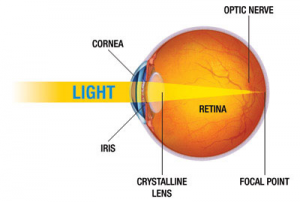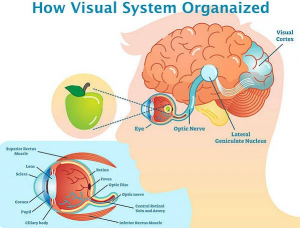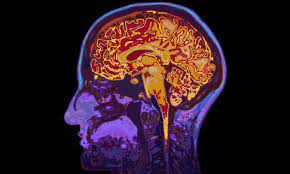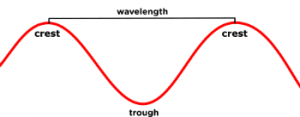How do you see? It seems a fairly basic question with a fairly obvious answer, doesn’t it?  But let’s think about it a little bit… I’m currently in my garden looking at a tree. There are birds flying around and I can hear them tweeting. How am I aware of all of this?
But let’s think about it a little bit… I’m currently in my garden looking at a tree. There are birds flying around and I can hear them tweeting. How am I aware of all of this?
Ok, well light is entering my eyes. I have to have my eyes open to see because it is the black pupil in the centre of my eye which absorbs the light. The pupil is just a hole which lets the light in and just before the pupil is a lens which focuses the light so, as all of the rays of light meet together at the back of my eye on the retina. The retina contains millions of light-sensitive nerve cells and is mostly focused on one place called the fovea.
When you are looking directly at something the light from that object is landing on the fovea (labelled ‘focal point’ in the diagram) and so it is the objects directly in front of your gaze which appears most in focus. You can have a play with a simulation here.
PHYSICS PRACTICE QUESTIONS – WHY ARE THEY SO ESSENTIAL?
How we paint the world in our minds
So, is this seeing then? Well no… I mean if the signal stopped at your retina (and for some people, this is the case) then you don’t see anything at all. It needs to go further before the ‘seeing’ takes place. Next up is the optic nerve which collects all of the information from all of those photo-receptive cells and carries them as electrical impulses toward your visual cortex. I suppose your visual cortex can be thought of as the primary processor of visual information, but it doesn’t end there. I won’t go into much more detail, because the point I want to make is that it is unclear when the ‘seeing’ actually happens.
To summarise,
we use information as rays of light collected by photoreceptive cells at the back of the eye (our retina). That information is sent towards the visual cortex via our optic nerve where it is processed. It is here that our brain decides what all of this information means and an image of the world is created. Our visual cortex cannot compare to anything else, it cannot confer with colleagues. Our visual cortex has to guess what this information means.
YOU WILL BE A DIFFERENT PERSON AFTER READING THIS POST
How quick is the processor in our brain?
Let us imagine you are driving a car or riding a bike. As you move around, turn your head, and move your eyeballs in their sockets, you are collecting information. This information is in the form of rays of light. Your brain needs to process that information quickly to get an up-to-date picture of what is happening. This happens so quickly that you are able to safely navigate around moving cars, pedestrians and stationary objects as well as work out which turning you need to make and so on. The more you think about it, the more incredible it is!
A wave’s frequency and wavelength
I shall produce a series of posts on waves at some point in the future. For now let us consider two properties of waves which are strongly linked: wavelength and frequency. Any wave is a repeating pattern of peaks and troughs. The wavelength is the distance you would have to travel before the wave repeats itself. The frequency of a wave is how many waves pass by a point per second, and is measured in hertz (Hz). So long as the speed remains constant, then as you increase the frequency, you decrease the wavelength.
ELECTRICAL RESISTANCE AND OHM’S LAW
How we invented colour
Our photoreceptive cells come in two types: Cones and rods. Rods are more sensitive to light and will detect a comparatively larger range of wavelengths and frequencies. Our rods are sensitive to a narrower range of wavelengths and are less sensitive to light in general, so are not great in low light conditions. We have three types of cones, each one sensitive to a different range of wavelengths and frequencies. This means that information as to what sort of frequency or wavelength the light is can be ascertained by our visual cortex by checking which ones detected light and which ones did not. For example, if the wavelength of the light is around 670nm (one nm is one-millionth of a millimetre) then only two of the rod cells will detect it and one of those two will detect it more than the other. This is when our brain ‘sees’ “red”. The rod cell which was most sensitive is called the ‘red’ rod cell. We also have green rod cells and blue rod cells. Each one is sensitive to a different range of wavelengths.
Ok. That’s it for today, part 2 will be looking at different types of seeing…
A bit about the author, Paul H:
 Paul is a qualified and experienced Physics, Maths, and Science teacher, now working as a full-time tutor, providing online tuition using a variety of hi-tech resources to provide engaging and interesting lessons. He covers Physics, Chemistry, Biology, and Science from Prep and Key Stage 3 through to GCSE and IGCSE. He also teaches Physics, Maths, and Chemistry to A-Level across all the major Exam Boards.
Paul is a qualified and experienced Physics, Maths, and Science teacher, now working as a full-time tutor, providing online tuition using a variety of hi-tech resources to provide engaging and interesting lessons. He covers Physics, Chemistry, Biology, and Science from Prep and Key Stage 3 through to GCSE and IGCSE. He also teaches Physics, Maths, and Chemistry to A-Level across all the major Exam Boards.


